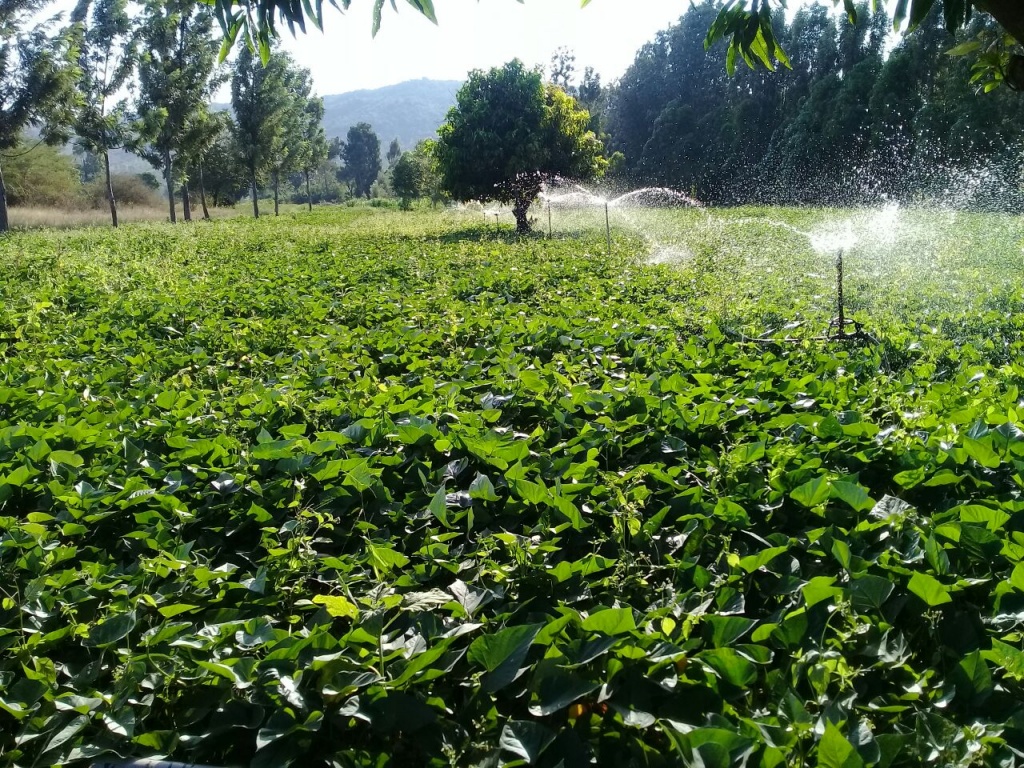
Nelson Ngaara's sweet potato farm with sprinklers open watering the crops. Sprinkler system are up to 15% more than the drip system which can be attributed to more vigorous growth due to rooting of the vine nodes on the wet soil between the beds.
Sweet potatoes farmers from Kirinyaga County have resorted to sprinkler irrigation system where water is distributed by overhead high-pressure sprinklers from a central location in the field in order to help them improve and maintain their crop production during this low rainfall period.
Kirinyaga County alone produces about 500 tons of sweet potatoes every year. This is used to produce flour, baking and chips or even sold in their fresh state for food.
However, the greatest challenge remains availability of reliable water throughout the season as most production is rain-fed.
Nelson Ngaara is sweet potato farmer in Sagana, Kirinyaga County. He says he has six sprinklers in his one acre piece of sweet potatoes land. He irrigate them once a week given they have over grown and their leaves and vines covering the ground reducing the rate of water lose through evaporation.
READ ALSO: Farmer helping others get clean high yielding sweet potatoes
READ ALSO: Promising sweet potato varieties in Western Kenya
READ ALSO: KALRO selling Mucinya' sweet potato that creeps 4X faster
“I irrigate my sweet potatoes once a week now that they have over grown but when they are still young with their leaves not yet spread enough I sprinkle water twice to enable roots development,” said Ngaara adding that the water he draws from River Tana has been of benefit to him and other farmers in the region.
He expects between 40-50 bags of potatoes from the land late October when he will be harvesting. His main markets are Sagana centre and Kagio where traders from Nairobi come occasionally to buy sweet potatoes from them.
Yields under sprinkler system are up to 15% more than the drip system which can be attributed to more vigorous growth due to rooting of the vine nodes on the wet soil between the beds. Root quality is superior to the tape system but weed growth is more of a problem. A mini-sprinkler system needs to be correctly designed to give complete and even ground cover.
Kenya’s potential to produce sweet potato for the export market is high due to favourable soil and vine quality plus water availability in production areas. Sweet pomato processing factory can be located at Kagio because of the area’s high production of the produce.
Experts say that root maturity of sweet potatoes can vary between varieties and root development is slower during cooler weather. Growers need to monitor the development of roots with regular checks of root size after 18 weeks. Marketable grades of roots are between 0.25 and 1 kilogram. If harvested at the correct time, around 60-70% of total roots should be within this grade. If grown during the dry season most varieties should be ready for digging at about 20 -22 weeks from planting. If left too long in the ground the roots can become oversize and unmarketable.
“The economy of Kenya relies on Agriculture. Eighty percent of the country is arid or semi-arid. In the arid and semi-arid areas sustainable agriculture can only be achieved through well planned and operated irrigation. The Government of Kenya has identified irrigation as an important tool for improving food self-sufficiency and enhancing household incomes in the rural sector,” writes M.K. Gakundi General Manager, Smallholder Irrigation Scheme Development Organization, Kenya in a FAO report.
















Comments powered by CComment